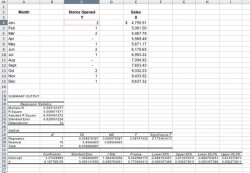Ok. So when the going gets tough and I don't have the answer (most of the time) I have to ask. Reading threads about the colleges and degrees people are getting impresses me, so now I'm going to toss this out there and see if anyone can help.
I would like to see if I cannot estimate the demand of a business and I believe I'd want to use the simple linear regression model. BUT what I do not know is what values I should take for X and Y. Obviously I'd want to use the most relevant data to compare. I thought I would use say the number of new store openings versus the net sales, but the number of new store openings is <=2. I don't know if this is good enough. It's relevant, but maybe not enough. A larger number is with the franchises developed so I decided to take that and I wanted to see the thoughts on the data.
I'm not using real numbers for the company, but I am using numbers that are around what the company is reporting and I do not think it's telling me what I want to know. I'm probably doing that wrong.
Is this not an appropriate way to estimate the demand for a business?
I would like to see if I cannot estimate the demand of a business and I believe I'd want to use the simple linear regression model. BUT what I do not know is what values I should take for X and Y. Obviously I'd want to use the most relevant data to compare. I thought I would use say the number of new store openings versus the net sales, but the number of new store openings is <=2. I don't know if this is good enough. It's relevant, but maybe not enough. A larger number is with the franchises developed so I decided to take that and I wanted to see the thoughts on the data.
I'm not using real numbers for the company, but I am using numbers that are around what the company is reporting and I do not think it's telling me what I want to know. I'm probably doing that wrong.
Is this not an appropriate way to estimate the demand for a business?


